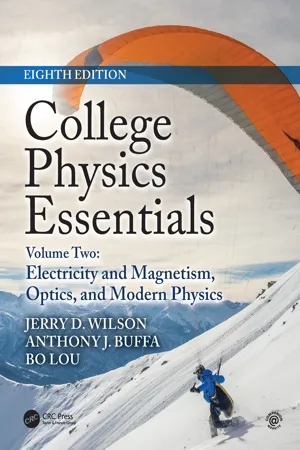Physics
Effective Resistance
Effective resistance refers to the total resistance in a circuit when resistors are combined in various ways, such as in series or parallel. It is a single equivalent resistance that represents the combined effect of multiple resistors. Calculating effective resistance is essential for analyzing and understanding the behavior of complex electrical circuits.
Written by Perlego with AI-assistance
Related key terms
Related key terms
1 of 4
Related key terms
1 of 3
3 Key excerpts on "Effective Resistance"
- eBook - ePub
- U.S. Bureau of Naval Personnel(Author)
- 2012(Publication Date)
- Dover Publications(Publisher)
The preceding discussion of current introduced certain principles involving the characteristics and effects of resistance in parallel circuits. A detailed explanation of the characteristics of parallel resistances will be considered in this section. The explanation will commence with a simple parallel circuit. Various methods used to determine the total resistance in parallel circuits will be described.In the example diagram (fig. 5-8 ), two cylinders of conductive material having a resistance value of 10 ohms each are connected across a 5-volt battery. A complete circuit consisting of two parallel paths is formed and current will flow as shown.Computing the individual currents shows that there is one-half an ampere of current flowing through each resistance. Accordingly, the total current flowing from the battery to the junction of the resistors, and returning from the resistors to the battery, is equal to 1 ampere. The total resistance of the circuit can be determined by substituting total values of voltage and current into the following equation. This equation is derived from Ohm’s law.This computation shows the total resistance to be 5 ohms, one-half the value of either of the two resistors.Figure 5-8.—Two equal resistors connected in parallel.Since the total resistance of this parallel circuit is smaller than either of the two resistors, the term “total resistance” does not mean the sum of the individual resistor values. The total resistance of resistors in parallel is also referred to as equivalent resistance. In many texts the terms total resistance and equivalent resistances are used interchangeably.There are several methods used to determine the equivalent resistance of parallel circuits. The most appropriate method for a particular circuit depends on the number and value of the resistors. For the circuit described above, the following simple equation is used: - eBook - ePub
Circuit Analysis with PSpice
A Simplified Approach
- Nassir H. Sabah(Author)
- 2017(Publication Date)
- CRC Press(Publisher)
2 Fundamentals of Resistive CircuitsObjective and Overview
This chapter introduces (1) the two ideal circuit elements of dc circuits, namely, resistors and sources; (2) the two basic circuit laws, namely, Kirchhoff’s current law (KCL) and Kirchhoff’s voltage law (KVL); and (3) the two basic connections between circuit elements, namely, series and parallel connections.The nature of electrical resistance is first explained using a simplified model, following which, the very basic Ohm’s law defining an ideal resistor is presented. Ideal, independent and dependent, voltage and current sources are then discussed, with emphasis on their defining and essential properties.Kirchhoff’s laws are introduced as laws derived from conservation of charge and conservation of energy, but which provide a much simpler means of analyzing circuit behavior. Series and parallel connections of circuit elements are then discussed and linked to Kirchhoff’s laws.PSpice simulations are introduced in this chapter and are included in all numerical examples, whenever appropriate, to illustrate and verify the results of analytical solutions. This chapter concludes with a very helpful problem-solving approach and illustrating it with examples.⋆ 2.1Nature of ResistanceConcept: Resistance is fundamentally due to impediments to the movement of current carriers in a conductor under the influence of an applied electric field.A sample of a metallic conductor typically consists of a large number of crystals in which the rest positions of the metal atoms at 0 K are arranged in a regular manner that is characteristic of the type of crystal. At temperatures above 0 K, (1) the crystal atoms vibrate, in randomly oriented directions, about their rest positions, with an amplitude of vibration that increases with temperature, and (2) some electrons, referred to as conduction electrons have sufficient energy to detach from their parent atoms and move freely in the crystal, in randomly oriented directions, at thermal velocities of the order of 107 - eBook - ePub
College Physics Essentials, Eighth Edition
Electricity and Magnetism, Optics, Modern Physics (Volume Two)
- Jerry D. Wilson, Anthony J. Buffa, Bo Lou(Authors)
- 2019(Publication Date)
- CRC Press(Publisher)
18 Basic Electric Circuits18.1 Resistances in Series, Parallel, and Series–Parallel CombinationsEquivalent Resistances18.2 Multiloop Circuits and Kirchhoff’s RulesJunction and Loop Rules Applied to Circuit Analysis18.3 RC CircuitsCharging/Discharging Capacitors18.4 Ammeters and VoltmetersElectrical Measurements: Design and Usage18.5 Household Circuits and Electrical SafetyThis photo shows that material (here saltwater) containing charged particles can be used to carry current and thus complete a circuit.Metallic wires are usually thought of as the connectors between elements in a circuit. However, wires are not the only conductors of electricity, as the circuit in the chapter-opening photo shows. Notice that the bulb is lit. Hence the circuit, which consists of batteries, wires, electrodes, and a saltwater solution, must be complete. The conclusion is that the solution itself must be a conductor. Circuits containing liquid conductors such as these have practical applications in the laboratory and industry; for example, they can be used to synthesize or purify chemical substances.Electric circuits are of many kinds and serve many specific purposes, from boiling water to providing light to restarting a heart. Building on the principles discussed previously, this chapter emphasizes the analysis and applications of electric circuits. Such analysis can be useful, for example, to check that a circuit will function properly as designed, or to be sure there would be no safety problems. As might be expected, our circuit analysis will rely heavily on circuit diagrams. (A few of these diagrams were employed in Chapter 17 .) To begin, let’s explore some of the ways that resistive elements, such as lightbulbs, can be connected.18.1 Resistances in Series, Parallel, and Series–Parallel CombinationsIn our discussions and diagrams, the resistance symbol can represent any
Index pages curate the most relevant extracts from our library of academic textbooks. They’ve been created using an in-house natural language model (NLM), each adding context and meaning to key research topics.
Explore more topic indexes
Explore more topic indexes
1 of 6
Explore more topic indexes
1 of 4


